SS Duilio Archival Collection
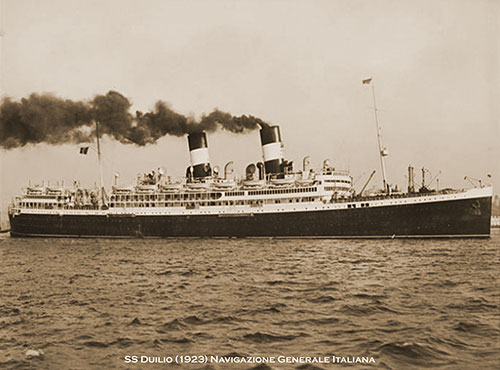
SS Duilio (1923) Navigazione Generale Italiana. | GGA Image ID # 2063a32b8d
Content Links
- Photo of the SS Duilio (1923) Navigazione Generale Italiana
- Duilio (1923) Navigazione Generale Italiana Ship's History (Brief)
- First Italian Super Ocean Liner - 1924
- Passage Contracts, Tickets, and Receipts
- Sailing Schedules
- Posters
- Books Referencing the SS Duilio
- Inspection of the SS Duilio - 1923
Duilio (1923) Navigazione Generale Italiana
Built by S. A. Ansaldo, Sestri, Ponente, Italy. Tonnage: 24,281. Dimensions: 602' x 76' (635' o.l.). Propulsion: Quadruple-screw, 19 knots. Four steam turbines. Masts and Funnels: Two masts and two funnels. Laid down, May 30, 1914. Launched, January 9, 1916. Maiden voyage: Genoa-Naples-New York, October 30,1923. Passengers: 280 first, 670 second, 600 third. Service Changes: Transferred to South American route in 1928. Ownership Change: Acquired by Lloyd Triestino in 1935. War Service: Served as an Italian hospital ship in World War II. Fate: Bombed and sunk at Trieste, July 10, 1944, while trying to escape from Allied forces in the closing days of the Italian invasion. Sister ship: Giulio Cesare.
First Italian Super Ocean Liner - 1924
SS Duilio was the first Italian super ocean liner and in 1923 was the latest product of Italian Shipbuilding craftsmanship, and one of the largest and fastest vessels in the Italian Merchant Marine. Her gross tonnage was 24,281, and the steamship was the sister of the SS Giulio Cesare that was launched in 1921.
Return to Content Links
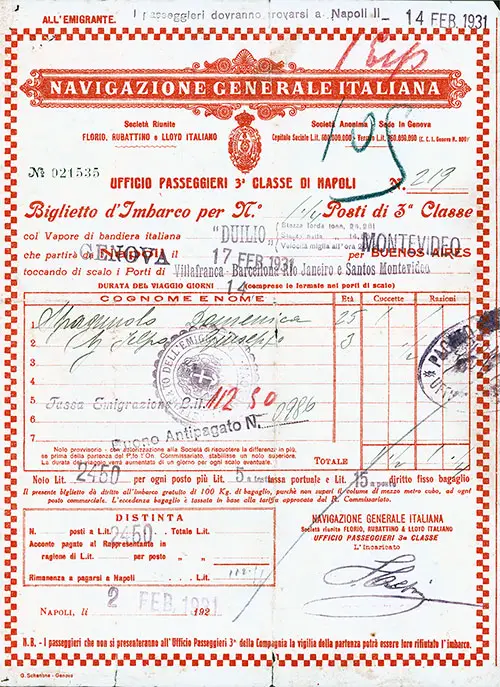
SS Duilio Passage Contract - 14 February 1931
Passage Ticket for a voyage on the SS Duilio of the NGI (Navigazione Generale Italiana) in third class from Genova to Buenos Aires dated 14 February 1931. Voyage ports of call included Villafranca, Barcelona, Rio Janeiro, and Santos Montevideo.
Return to Content Links
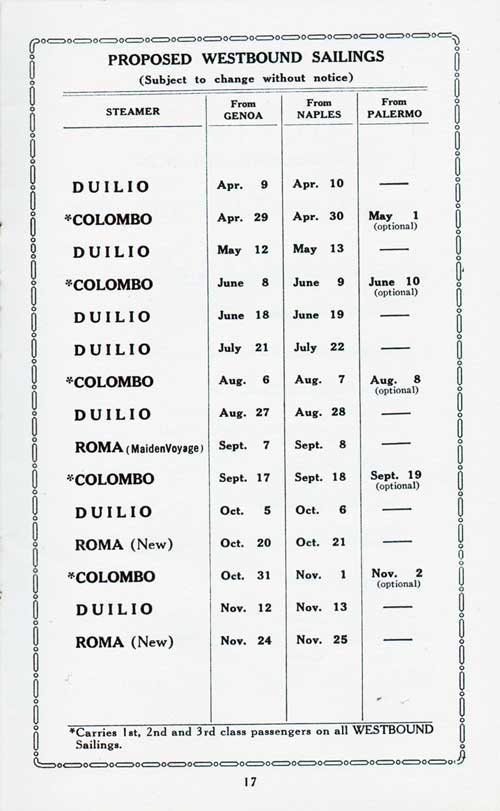
Sailing Schedule, Wesbound from Genoa-Naples-Palermo to New York, from 9 April 1926 to 25 November 1926. Ships Included the Colombo, Duilio, and Roma. SS Colombo Passenger List, 10 April 1926. | GGA Image ID # 1e60054906
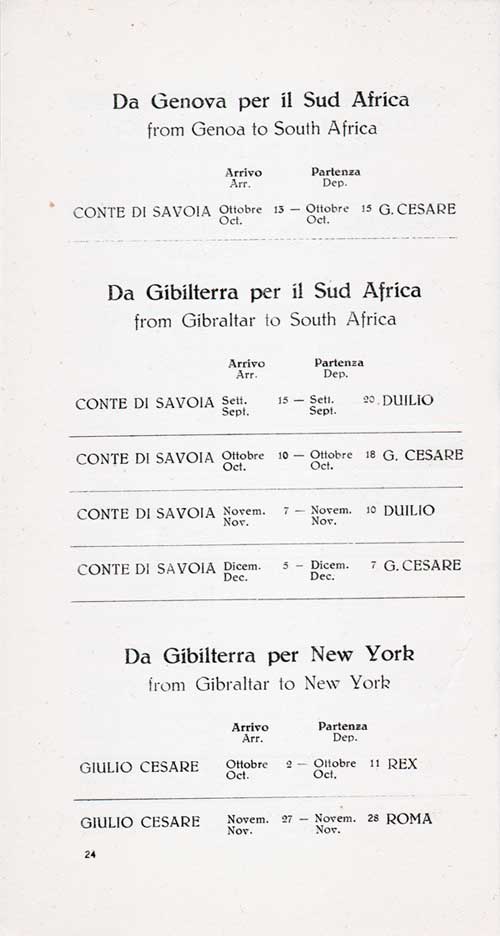
Principal Connections of the Italia Line, Cosulich Line, and Lloyd Triestino, from Genoa to South Africa, Gibraltar to South Africa, and Gibraltar to New York, from 15 September 1935 to 5 December 1935. Connecting Ships Included the Giulio Cesare, Duilio, Rex, and Roma. Transatlantic Ships Included the Conte di Savoia and Giulio Cesare. SS Rex Passenger List, 13 September 1935. | GGA Image ID # 1ee5cb43d8
Return to Content Links
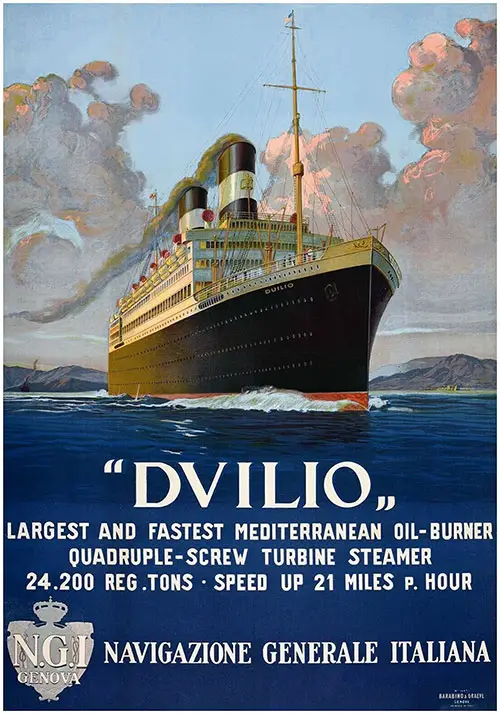
1920s Poster of the Navigazione Generale Italiana Liner SS Duilio -- The Largest and Fastest Mediterranean Oil Burner, Quadruple-Screw Turbine Steamer of 24,206 Reg. Tons, with a Speed of up to 18.25 Knots. | GGA Image ID # 1dadb07c2d
Return to Content Links
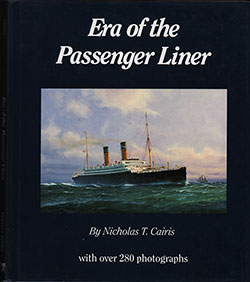
Era of the Passenger Liner - 1992
The Gilded Era comes back to life as the reader relives the careers of stately ships and express greyhounds from immigrant ships to floating palaces. Scarce, large format book containing 288pp. Features photographs, statistics, and background of 280 passenger liners, each with a picture.

The Fabulous Interiors of the Great Ocean Liners - 1984
Some 200 superb photographs—in long shots and close-ups—capture exquisite interiors of world's great "floating palaces"—1890s to 1980s: Titanic, Île de France, Queen Elizabeth, United States, Europa, more. Informative captions provide key details.
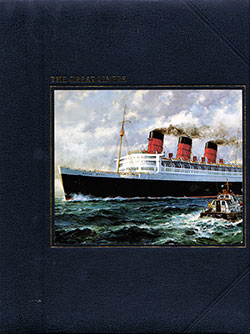
The Great Liners: The Seafarers, Volume 4
A history of the world's famous luxury liners provides portraits of the ships. It examines such great disasters as the sinking of the Titanic. This edition explores the grand hotels that traversed the Atlantic between 1840 and 1930.
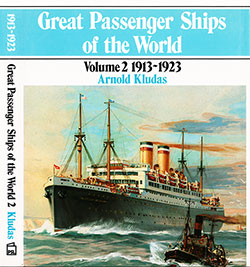
Great Passenger Ships of the World 1913-1923
The period 1913-1923 is dealt with in this second volume. Although it was only a decade, it was one of the most turbulent passenger ships in history. Competition to produce ever-larger vessels declined between leading North Atlantic shipping companies. For 20 years, the ships of the Imperator Class were the largest in the world.

Majesty at Sea: The Four Stackers
The opulent and luxurious four-funnel passenger liners, of which only fourteen have ever been built, are unsurpassed in maritime history. Built between 1897 and 1921, these great vessels vied with each other in their standards of comfort, spaciousness, and speed, and great was the rivalry between their owners.
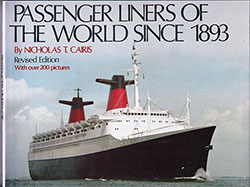
Passenger Liners of the World Since 1893
The author here takes a nostalgic look back to the heyday of the passenger ship, providing a brief history of 211 ships of over 10,000 tons, together with specifications and technical details of each.
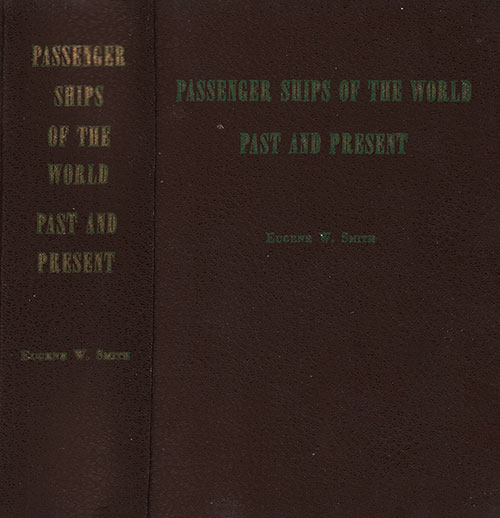
Passenger Ships of the World - 1963
🎓 “A Global Voyage Through Steamship History for Historians, Genealogists, and Maritime Enthusiasts”
Eugene W. Smith’s Passenger Ships of the World – Past and Present (1963) is a masterfully curated encyclopedic reference that charts the rise, peak, and transformation of ocean-going passenger ships through nearly two centuries. Expanding upon his earlier Trans-Atlantic and Trans-Pacific works, Smith offers a global maritime panorama that includes ships serving the Americas, Africa, Europe, Asia, Australia, and Oceania, as well as Canal routes and California-Hawaii shuttle lines.
🧭 This book is an essential resource for:
- Maritime historians seeking design evolution and fleet data
- Genealogists tracing voyages and shipping lines
- Educators and students studying transoceanic migration and tourism
- Ship modelers, naval architects, and enthusiasts interested in dimensions, tonnage, and speed
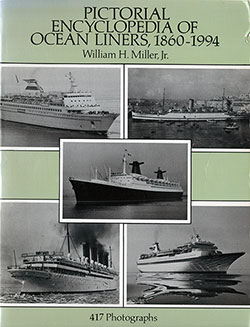
Pictorial Encyclopedia of Ocean Liners, 1860-1994
One of the most comprehensive pictorial references on ocean liners ever published, this superb chronicle by noted maritime historian William H. Miller, Jr., depicts and describes virtually every passenger ship of over 15,000 tons built between 1860 and the late 1900s.
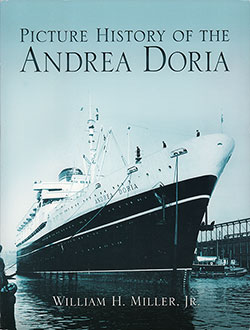
Picture History of the Andrea Doria
Graceful, fast, and luxuriously outfitted, the Andrea Doria was one of the most famous ships of the 20th century. On July 26, 1956, three years after its inaugural voyage, the famous Italian liner was assured of an immortal place in maritime history after colliding with another vessel off the New England coast and sinking.
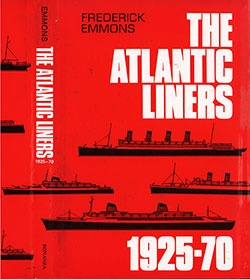
THE ATLANTIC LINERS will be cherished by all the millions of Americans who love the sea. Frederick Emmons sketches the histories of every ocean liner that sailed between the United States and Europe between 1925 and 1970.
Return to Content Links
SS Duilio is the latest product of Italian shipbuilding craftsmanship and one of the largest and fastest vessels in the Italian merchant marine industry, arriving on Maiden Voyage.
By D. H. P.
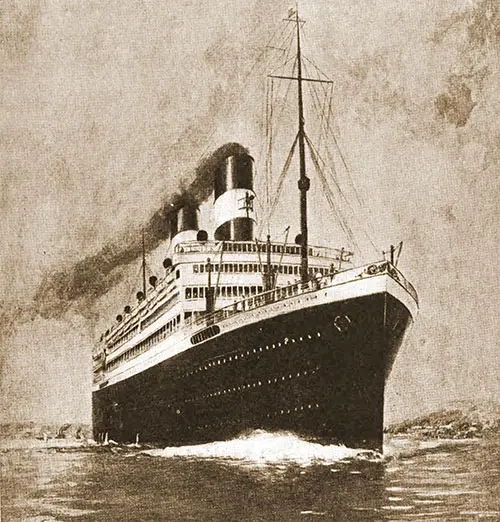
The Palatial Italian-American Liner SS Duilio of the NGI. The Marine Journal, 17 November 1923. | GGA Image ID # 20639824bc
There were many interested visitors aboard the S. S. Duilio of the Navigazione Generale Italiana last Thursday afternoon when this latest addition to the company's fleet was opened by invitation to the shipping fraternity for inspection.
We had already examined the Giulio Cesare, a sister ship of the Duilio, some time ago and were consequently looking forward to something of a treat, for these new Italian passenger liners invariably offer many points of interest to the discriminating observer.
Well, we were satisfied. Without comparing her predecessors' disadvantages, we are inclined to believe that Duilio has certain little refinements and excellences that place her distinctly in a class by herself.
Who, for instance, could, in the ordinary course of events, expect to wake up in the morning in a de luxe stateroom and find a rare etching or an old print on the wall at the foot of the bed? But, believe me, brethren, this is just what passengers on the Duilio will find, and much more besides. Upon closer examination, they will discover that the rare prints are firmly secured to the walls, perhaps to save them from being tossed about in rough weather.
It isn't easy to combine extreme elegance with good taste. Even costly decorators sometimes need to give more than just the proper touch. But the Duilio has been fortunate to come from a country that can distinguish between the garish display and a certain deftly ornate elegance that impresses one as much by its simple dignity as by its sheer craftsmanship.
There is an enormous amount of handcarving and excellent artwork on the Duilio. However, all the comfort and efficient service points have yet to be sacrificed. The public rooms are spacious and have been arranged to give the impression of covering much more space than they do.
Glass paneled doorways and convenient corridors have been effectively utilized to provide a roomy, open effect. One small suggestion might be good, and this, which is of minor importance, relates to commercial signs on the lounge deck. These trade posters conflict with the general scheme of things.
The main dining saloon was one of the most convenient and attractive we have seen in some time. The color scheme is just right, and the tables on a roomy mezzanine gallery give an indefinable air of festivity. The napery and silverware attracted our attention.
There was a particular "style" about how the food was served, and the stewards were uniformly courteous and watchful. On this occasion, flowers were a feature of the table decorations, and they blended well with the color scheme of the saloon.
The chefs on board the Duilio are no friends of fat men, for they have a way of preparing table delicacies and other tempting viands that conquer the strongest resolutions of those who would eat sparingly and grow thin.
Between their artistry and the good-natured insistence of the chief steward, who seemed to be everywhere at once on this occasion, the writer of this article felt like Sir John Falstaff, who was reputed to measure three yards around. However, he is of average proportions and has occasionally been referred to as thin when in company with hefty men. These are general impressions.
In conclusion, we will give a few specific facts about the Duilio, which is undoubtedly one of the finest ships in the Italian Merchant Marine. The Duilio, named after a celebrated Roman Commander, is 600 feet long, 76 feet beam, and has a registered tonnage 22,000.
Her propelling machinery consists of triple expansion engines, which drive her quadruple screws, developing a speed of 21 knots. On her maiden voyage from Naples to New York, she broke all previous speed records for the run, covering the entire distance in 8 days and 16 hours.
The Duilio was built in Genoa, Italy, by the Ansaldo Company, and she has accommodations for 277 passengers in the first cabin, 684 in the second cabin, and 800 steerage.
"Palatial Italian-American Liner Wins Praise at Inspection," in The Marine Journal: America's Leading Marine Weekly, New York: The Marine Journal Company, Volume 47, No. 20, 17 November 1923, pp. 16-17.
Return to Content Links
